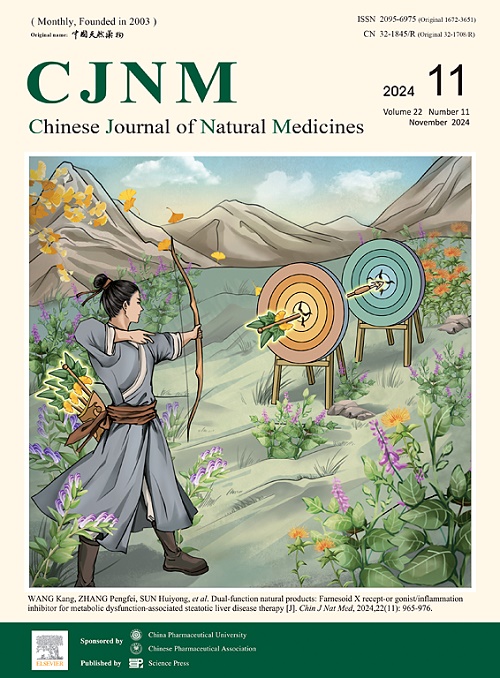84-B10 激活 LONP1 可通过重建线粒体和过氧化物酶体平衡缓解马兜铃酸肾病
IF 4
2区 医学
Q1 INTEGRATIVE & COMPLEMENTARY MEDICINE
引用次数: 0
摘要
从含有马兜铃酸(AAs)的马兜铃科草药中提取的药物配方被广泛用于医疗目的。然而,接触这些植物和分离出的 AAs 会引起肾毒性,即 AA 肾病(AAN)。目前,AAN 的发病机制尚未完全明了,导致治疗策略不尽人意。在这项研究中,我们探讨了 84-B10(5-[[2-(4-甲氧基苯氧基)-5-(三氟甲基)苯基]氨基]-5-氧代-3-苯基戊酸)对 AAN 的保护作用。RNA-seq分析显示,线粒体和过氧物酶体是AAN小鼠经84-B10治疗后受影响最大的细胞成分。一致的是,84-B10 治疗保留了线粒体的超微结构,恢复了线粒体呼吸,提高了参与线粒体脂肪酸 β 氧化的关键转运体(肉碱棕榈酰基转移酶 2)和酶(酰基辅酶 A 脱氢酶,中链)的表达,并减少了马兜铃酸 I(AAI)挑战小鼠肾脏和培养的近端肾小管上皮细胞中线粒体 ROS 的生成。此外,84-B10 还能增加参与过氧化物酶体脂肪酸 β 氧化的关键转运体(ATP 结合盒亚族 D)和限速酶(酰基-CoA 氧化酶 1)的表达,并恢复过氧化物酶体的氧化还原平衡。敲除 LONP1 的表达会降低 84-B10 对 AAN 的保护作用,这表明保护作用依赖于 LONP1。总之,我们的研究提供了证据,证明 AAN 与线粒体和过氧化物酶体功能的显著紊乱有关。LONP1 激活剂 84-B10 可能通过维持线粒体和过氧物酶体的平衡,对 AAN 具有治疗潜力。本文章由计算机程序翻译,如有差异,请以英文原文为准。
Activation of LONP1 by 84-B10 alleviates aristolochic acid nephropathy via re-establishing mitochondrial and peroxisomal homeostasis
Pharmaceutical formulations derived from Aristolochiaceae herbs, which contain aristolochic acids (AAs), are widely used for medicinal purposes. However, exposure to these plants and isolated AAs is linked to renal toxicity, known as AA nephropathy (AAN). Currently, the mechanisms underlying AAN are not fully understood, leading to unsatisfactory treatment strategies. In this study, we explored the protective role of 84-B10 (5-[[2-(4-methoxyphenoxy)-5-(trifluoromethyl) phenyl] amino]-5-oxo-3-phenylpentanoic acid) against AAN. RNA-seq analysis revealed that the mitochondrion and peroxisome were the most affected cellular components following 84-B10 treatment in AAN mice. Consistently, 84-B10 treatment preserved mitochondrial ultrastructure, restored mitochondrial respiration, enhanced the expression of key transporters (carnitine palmitoyltransferase 2) and enzymes (acyl-Coenzyme A dehydrogenase, medium chain) involved in mitochondrial fatty acid β-oxidation, and reduced mitochondrial ROS generation in both aristolochic acid I (AAI)-challenged mice kidneys and cultured proximal tubular epithelial cells. Additionally, 84-B10 treatment increased the expression of key transporters (ATP binding cassette subfamily D) and rate-limiting enzymes (acyl-CoA oxidase 1) involved in peroxisomal fatty acid β-oxidation and restored peroxisomal redox balance. Knocking down LONP1 expression diminished the protective effects of 84-B10 against AAN, suggesting LONP1-dependent protection. In conclusion, our study provides evidence that AAN is associated with significant disturbances in both mitochondrial and peroxisomal functions. The LONP1 activator 84-B10 demonstrates therapeutic potential against AAN, likely by maintaining homeostasis in both mitochondria and peroxisomes.
求助全文
通过发布文献求助,成功后即可免费获取论文全文。
去求助
来源期刊

Chinese Journal of Natural Medicines
INTEGRATIVE & COMPLEMENTARY MEDICINE-PHARMACOLOGY & PHARMACY
CiteScore
7.50
自引率
4.30%
发文量
2235
期刊介绍:
The Chinese Journal of Natural Medicines (CJNM), founded and sponsored in May 2003 by China Pharmaceutical University and the Chinese Pharmaceutical Association, is devoted to communication among pharmaceutical and medical scientists interested in the advancement of Traditional Chinese Medicines (TCM). CJNM publishes articles relating to a broad spectrum of bioactive natural products, leading compounds and medicines derived from Traditional Chinese Medicines (TCM).
Topics covered by the journal are: Resources of Traditional Chinese Medicines; Interaction and complexity of prescription; Natural Products Chemistry (including structure modification, semi-and total synthesis, bio-transformation); Pharmacology of natural products and prescription (including pharmacokinetics and toxicology); Pharmaceutics and Analytical Methods of natural products.
 求助内容:
求助内容: 应助结果提醒方式:
应助结果提醒方式:


